 W
WAaveqaspis is a genus of small marine arthropods of unclear affiliation, that lived during the early Cambrian period. Fossil remains of Aaveqaspis were collected from the Lower Cambrian Sirius Passet fossil-Lagerstätte of North Greenland. Aaveqaspis looks like a soft eyeless trilobite with a weakly defined axis, a headshield with stubby genal spines, 5 thorax segments also ending in stubby genal spines, and a tailshield (pygidium) with a pair of massive tusk-like spines, and two smaller spines near the end of the axis. The only species presently known is A. inesoni.
 W
WActaeus is a Cambrian organism with a resemblance to the great appendage arthropods. It is known from a single specimen recovered from the Burgess Shale of British Columbia, Canada. The specimen is over 6 cm long and has a body consisting of a head shield, 11 body tergites, and a terminal plate.
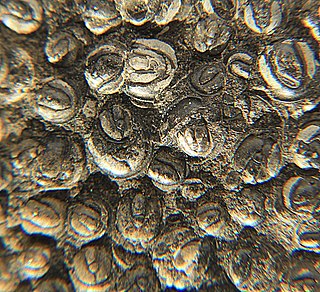 W
WAgnostus Wahlenberg, 1818; non Linnaeus, is a genus of agnostid trilobite belonging to the Family Agnostidae, McCoy (1849) that lived during the late Middle Cambrian – early Upper Cambrian. It is the type genus of the family Agnostidae and is subdivided into two subgenera, Agnostus and Homagnostus.
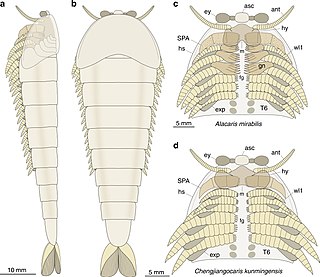 W
WAlacaris is an extinct genus of fuxianhuiid arthropod known from the Cambrian period. It is only known from the type species Alacaris mirabilis from the Cambrian Stage 3 aged Xiaoshiba Lagerstätte in Yunnan Province, China. It is morphologically similar to Chengjiangocaris, with which it forms a clade within Fuxianhuiida. Individuals reach a maximum of 12 centimetres in length, with a trunk consisting of 13 tergites. The basal region of the post-deutocerebral limbs were used in feeding, with the rhythmic movement of the legs guiding food towards the mouth along the food groove between the limbs, with gnathobases present near the mouth to macerate food.
 W
WAmplectobelua is an extinct genus of late Early Cambrian amplectobeluid radiodont, a group of stem arthropods that most of them were lived as free-swimming predators during the first half of the Paleozoic Era.
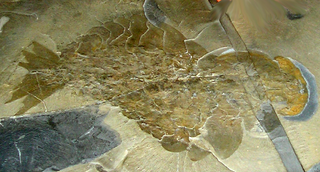 W
WAnomalocaris is an extinct genus of radiodont (anomalocaridid), an order of animals thought to be closely related to ancestral arthropods. The first fossils of Anomalocaris were discovered in the Ogygopsis Shale by Joseph Frederick Whiteaves, with more examples found by Charles Doolittle Walcott in the Burgess Shale. Originally several fossilized parts discovered separately were thought to be three separate creatures, a misapprehension corrected by Harry B. Whittington and Derek Briggs in a 1985 journal article. Anomalocaris is thought to be one of the earliest examples of an apex predator, though others have been found in older Cambrian lagerstätten deposits.
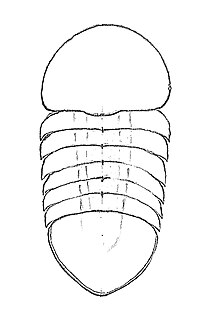 W
WBuenaspis is a genus of small marine arthropods in the family Liwiidae, that lived during the early Cambrian period. Fossil remains of Buenaspis were collected from the Lower Cambrian Sirius Passet Lagerstätte of North Greenland. Buenaspis looks like a soft eyeless trilobite. It has a headshield slightly larger than the tailshield (pygidium), and in between them six thoracic body segments (somites). The genus is monotypic, its sole species being Buenaspis forteyi.
 W
WBurgessia is an extinct genus of arthropod from the Middle Cambrian. Its fossils have been found in the Burgess Shale in British Columbia, Canada. Many of its fossils have been found. 1383 specimens of Burgessia are known from the Greater Phyllopod bed, where they comprise 2.63% of the community.
 W
WCambroraster is an extinct genus of hurdiid radiodont, dating to the middle Cambrian, and represented by the single formally described species Cambroraster falcatus. Hundreds of specimens were found in the Burgess Shale, and described in 2019. A large animal at up to 30 cm long, it characterized by a significantly enlarged horseshoe-shaped dorsal carapace (H-element), and presumably fed by sifting through the sediment with its well-developed tooth plates and short frontal appendages with hooked spines. It is named partially after the fictional Millennium Falcon, which its dorsal carapace resembles.
 W
WCanadaspis is an extinct genus of Cambrian-aged crustacean or euarthropod, a benthic feeder that moved mainly by walking and possibly used its biramous appendages to stir mud in search of food. The genus has been placed within the subclass Phyllocarida, in the class Malacostraca that includes shrimps and lobsters.
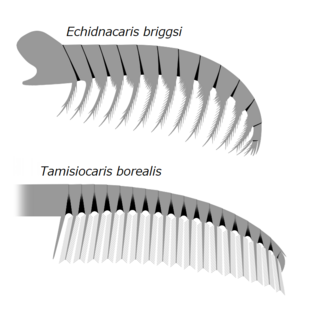 W
WCetiocaridae is a clade of radiodont, an extinct stem-group arthropods. The group was named after the Bearded Ceticaris in the speculative paleoart book All Your Yesterdays by John Meszaros. In later studies the group was renamed as a radiodont family Tamisiocarididae.
 W
WChengjiangocaris is an extinct genus of a shrimp-like arthropod that lived during the Cambrian. The genus is a type of fuxianhuiid, which are basal euarthropods. Five 520 million-year-old fossil specimens of C. kunmingensis were excavated in southern China and first reported in 2013 by Javier Ortega-Hernández and his colleagues. One specimen shows detailed evidence of a nervous system, "the fossil may be the oldest and most detailed example of a central nervous system yet identified, with even individual nerves -- rarely preserved soft tissue -- visible enough to study."
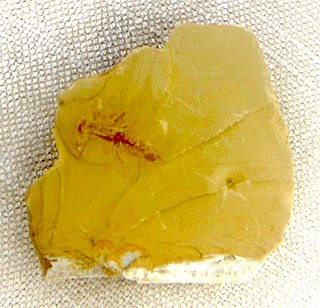 W
WCindarella is genus of trilobite-like Cambrian arthropod known from the Chengjiang biota of China. It is classified as in the stem group of trilobites (Artiopoda) in the clade Xandarellida, along with Phytophilaspis, Sinoburius, and Xandarella.
 W
WDinocaridida is a proposed taxon of extinct fossil arthropod-like marine animals found, with one exception, in the Cambrian and Ordovician. The name of Dinocaridids comes from Greek, "deinos" and "caris", meaning "terror shrimp" or "terror crab", due to their crustacean-like appearance and the hypotheses suggesting that members of this class were amongst the dominating and most diverse apex predators of their time. Dinocaridids occasionally referred as 'AOPK group' by some literatures, as the group compose of Radiodonta, Opabinia, Pambdelurion and Kerygmachela. It is probably paraphyletic, with Kerygmachela and Pambdelurion more basal than the Opabinia and Radiodonta clade.
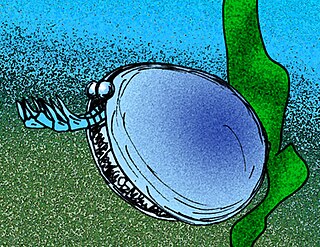 W
WForfexicaris valida is a species of Lower Cambrian arthropod, the only species in the family Forfexicarididae. It is known from only two specimens from the Maotianshan shale Lagerstätte.
 W
WFuxianhuia is a genus of Lower Cambrian fossil arthropod known from the Chengjiang fauna in China. Its purportedly primitive features have led to its playing a pivotal role in discussions about the euarthropod stem group. Nevertheless, despite being known from many specimens, disputes about its morphology, in particular its head appendages, have made it one of the most controversial of the Chengjiang taxa, and it has been discussed extensively in the context of the arthropod head problem.
 W
WGuangweicaris is an extinct genus of fuxianhuiid arthropod known from the Cambrian period. It is only known from the type species Guangweicaris spinatus, which is known from the Cambrian Stage 4 Guanshan Biota near Kunming. It is currently the latest known fuxianhuiid. It was first described in 2007, and was given a comprehensive re-description in 2020. It is currently known from over 150 specimens. Within the fuxianhuiids it is sister to Fuxianhuia, together forming the clade Fuxianhuiidae. In comparison to Fuxianhuia it has a wide, oval shaped opisthothorax and a proportionally longer, narrow tail-like abdomen, with 3 prothoracic tergites, 5 opisthothoracic tergites and 7 abdominal tergites, it also possesses a row of spines running down the central axis of the body from the second opisthothoracic tergite.
 W
WHabelia is an genus of extinct arthropod from the Middle Cambrian. Its fossils have been found in the Burgess Shale in British Columbia, Canada. Fifty-four specimens of Habelia are known from the Greater Phyllopod bed, where they comprise 0.1% of the community. While previously enigmatic, a 2017 restudy found that it formed a clade (Habeliida) with Sanctacaris, Utahcaris, Wisangocaris and Messorocaris as a stem-group to Chelicerata.
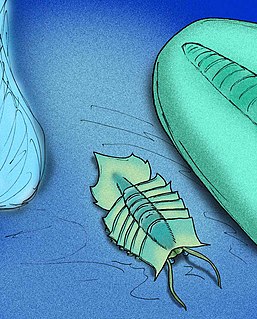 W
WHelmetia is an extinct genus of arthropod from the middle Cambrian. Its fossils have been found in the Burgess Shale of Canada and the Jince Formation of the Czech Republic.
 W
WHurdia is an extinct genus of hurdiid radiodont that lived 505 million years ago during the Cambrian Period. As a radiodont like Peytoia and Anomalocaris, it is part of the ancestral lineage that led to euarthropods.
 W
WHymenocaris is a genus of Cambrian crustaceans.
 W
WIsoxys is a genus of extinct, pelagic bivalved arthropod; the various species may have been roam-swimming predators. It had a pair of large spherical eyes, and two large appendages It is possible that these appendages are homologous to the great appendages of radiodonts and megacheirans.
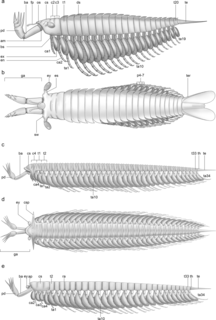 W
WJianfengia is an extinct genus of Middle Cambrian (Atdabanian) Megacherian arthropod found in the Maotianshan Shale Lagerstätte of China. It contains the single species Jianfengia multisegmentalis.
 W
WKerygmachela kierkegaardi was a gilled lobopodian from the Buen Formation of the Sirius Passet Lagerstätte, in northern Greenland. Its anatomy strongly suggests that it, along with its relative Pambdelurion whittingtoni, was a close relative of anomalocaridid (radiodont) and euarthropod. The specific name, "kierkegaardi" honors Danish philosopher Søren Kierkegaard.
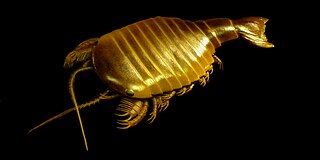 W
WMerostomoidea is a paraphyletic group of fossil arthropods. They have been described as a transitional form between trilobites and true chelicerates.
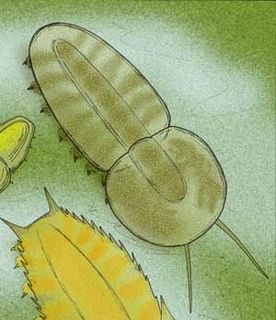 W
WMisszhouia is a genus of small to average sized marine arthropods within the Naraoiidae family, that lived during the early Cambrian period. The only species presently known is Misszhouia longicaudata.
 W
WMolaria is a genus of Cambrian arthropod, the type species M. spinifera is known from the Middle Cambrian Burgess Shale. 144 specimens of Molaria are known from the Greater Phyllopod bed, where they comprise 0.27% of the community. A second species M. steini was described from the Sirius Passet in Greenland in 2017.
 W
WMollisonia is a genus of epifaunal detritivorous arthropod. Species are known from the Cambrian Burgess Shale, Langston Formation and Wheeler Shale of North America, as well and the Chenjiang Biota of China. Twenty-one specimens of Mollisonia are known from the Greater Phyllopod bed, where they comprise less than 0.1% of the community. Remains attributed to the genus are also known from the Ordovician Fezouata Formation of Morocco and Greenland. An observation published in 2019 suggest this genus is a basal chelicerate, closer to crown group chelicerata than members of Habeliida. It is suggested to be closely related to Corcorania, Ecnomocaris and Thelxiope, together forming the clade Mollisoniida.
 W
WMyoscolex is an early animal species known from the Cambrian Emu Bay Shale in South Australia. Originally interpreted as an annelid, it seems to be an arthropod; the possible presence of an Opabinia-like proboscis, eyes, and flaps suggests a plausible relationship with that species. Myoscolex is the earliest known example of phosphotized muscle tissue, and as to which shows distinct annulation.
 W
WOccacaris oviformis is an extinct nektonic predatory arthropod from the Lower Cambrian Maotianshan shale Lagerstätte. It bears a superficial resemblance to the Cambrian arthropod, Canadaspis, though, was much smaller, and had a pair of "great appendages", with which it may have grasped prey.
 W
WOpabinia regalis is an extinct, stem group arthropod found in the Middle Cambrian Burgess Shale Lagerstätte of British Columbia, Canada. It flourished from 505 million years ago to 487 million years ago during the Cambrian Period of the Paleozoic Era. It measured 2-3 inches in length and is presumed to have been a carnivore. Fewer than twenty good specimens have been described; 3 specimens of Opabinia are known from the Greater Phyllopod bed, where they constitute less than 0.1% of the community. Opabinia was a soft-bodied animal, averaging about 5.7 cm in length, and its segmented body had lobes along the sides and a fan-shaped tail. The head shows unusual features: five eyes, a mouth under the head and facing backwards, and a proboscis that probably passed food to the mouth. Opabinia probably lived on the seafloor, using the proboscis to seek out small, soft food.
 W
WPambdelurion whittingtoni is an extinct, nektonic organism from the Sirius Passet Lagerstätte, from Cambrian Greenland. Its anatomy strongly suggests that it, along with its relative Kerygmachela kierkegaardi, was either an anomalocarid or a close relative thereof.
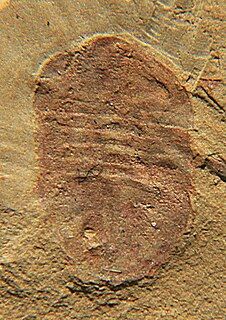 W
WPanlongia was a small-sized marine arthropod, with an oval-shaped non-calcified exoskeleton. Both the head shield and the tail shield are semi-circular. In between cephalon and pygidium are four thoracic body segments (somites). The cephalon occupies approximately ⅓ of the body length, the thorax ¼ and pygidium about 45%. Panlongia lived during the late Lower Cambrian (Botomian) in what is today South China. In Panlongia spinosa the edge of the exoskeleton carries several small sawtooth-like spines, that are absent in P. tetranodusa.
 W
WParanomalocaris is a genus of primitive radiodont recovered from eastern Yunnan. It contains a single species, Paranomalocaris multisegmentalis. It is only known from its frontal appendage. The frontal appendage features endites with numerous auxiliary spines, and at least 22 segments (podomeres), hence the specific name multisegmentalis.
 W
WParapeytoia was a prehistoric animal that lived over 530 million years ago in the Maotianshan shales of prehistoric China. It was interpreted as an anomalocaridid (radiodont) with legs, but later studies reveal it was a megacheiran, a group of arthropods which are no longer thought to be closely related to the radiodonts.
 W
WPectocaris spatiosa is a Cambrian arthropod from the Maotianshan Shale similar in form to the Burgess Shale crustaceomorph Odaraia.
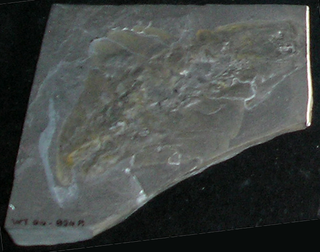 W
WPeytoia is a genus of anomalocarids that lived in the Cambrian period, containing two species, Peytoia nathorsti and Peytoia infercambriensis. Its two mouth appendages had long bristle-like spines, it had no fan tail, and its short stalked eyes were behind its mouth appendages.
 W
WProtocaris marshi is an extinct Cambrian arthropod that superficially resembles branchiopod notostracan crustaceans of the genus Triops.
 W
WSarotrocercus is a small Cambrian organism known from Burgess shale-type localities, reaching a centimetre or two in length (0.39–0.79 in). It was pelagic and swam on its back. 28 specimens of Sarotrocercus are known from the Greater Phyllopod bed, where they comprise < 0.1% of the community. It may lie in the arthropod crown group, and a recent study has revised some points of its original description.
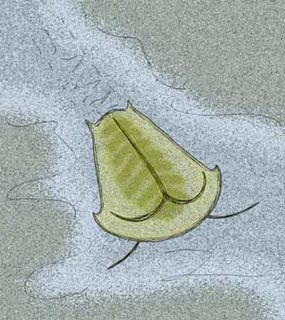 W
WSkania is a Middle Cambrian fossil arthropod that is closely related to the Early Cambrian Primicaris larvaformis from the Chengjiang Biota, China. It bears a superficial resemblance to the Ediacaran organism Parvancorina. A single specimens of Skania are known from the Greater Phyllopod bed, where they comprise < 0.01% of the community. While previously enigmatic, it is now thought to be a marrellomorph.
 W
WTamisiocaris is an anomalocaridid taxon initially only known from frontal appendages from the Buen Formation in Sirius Passet. Further specimens revealed that the frontal appendages were segmented and bearing densly-packed auxiliary spines, which were adapted to suspension feeding in a manner analogous to modern baleen whales.
 W
WTegopelte gigas is a species of soft-bodied arthropod known from two specimens from the Walcott Quarry. Trackways that may have been produced by this organism or a close relative are known from the Kicking Horse Shale, stratigraphically below its body fossil occurrences. T. gigas is the only species classified under the genus Tegopelte. It is usually classified under its own family Tegopeltidae, but is sometimes placed under the family Naraoiidae. It is currently considered a member of Conciliterga within the Artiopoda.
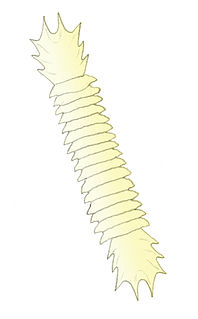 W
WUrokodia aequalis is an extinct genus of arthropod from the early Cambrian. The taxon is only known from the Maotianshan Shales of China based on some 15 specimens. It segmentation resembles that of a millipede and it possessed head and tail shields with thorny spikes. It has some similarities to the arthropod Mollisonia that is known from both the Burgess Shale of Canada and the Kaili biota of China. Recently, the taxon has been considered a member of the order Mollisoniida, alongside Mollisonia, Thelxiope, and Corcorania, the group are suggested to be stem-chelicerates.
 W
WWaptia fieldensis is an extinct species of arthropod from the Middle Cambrian Burgess Shale Lagerstätte of Canada. It grew to a length of about 8 cm (3 in) and resembled modern shrimp in both morphology and habit. It had a large bivalved carapace and a segmented body terminating into a pair of tail flaps. It was an active swimmer, feeding on organic particles it gathered from the seafloor substrate. It is also one of the oldest animals with direct evidence of brood care.
 W
WWaptiidae is an extinct family of shrimp-like stem group crustaceans that lived during the Early to Middle Cambrian. It is the only family classified under the order Waptiida which is tentatively included in the clade Crustaceomorpha.